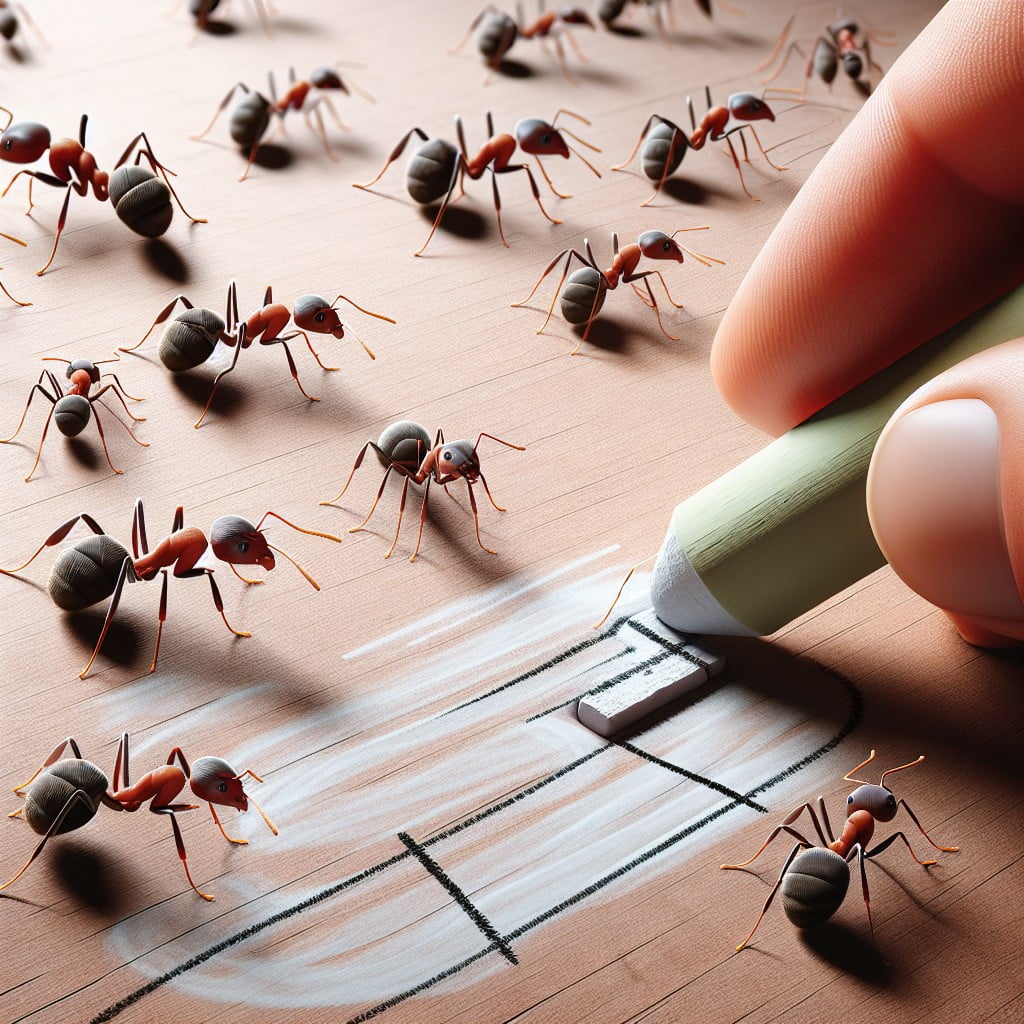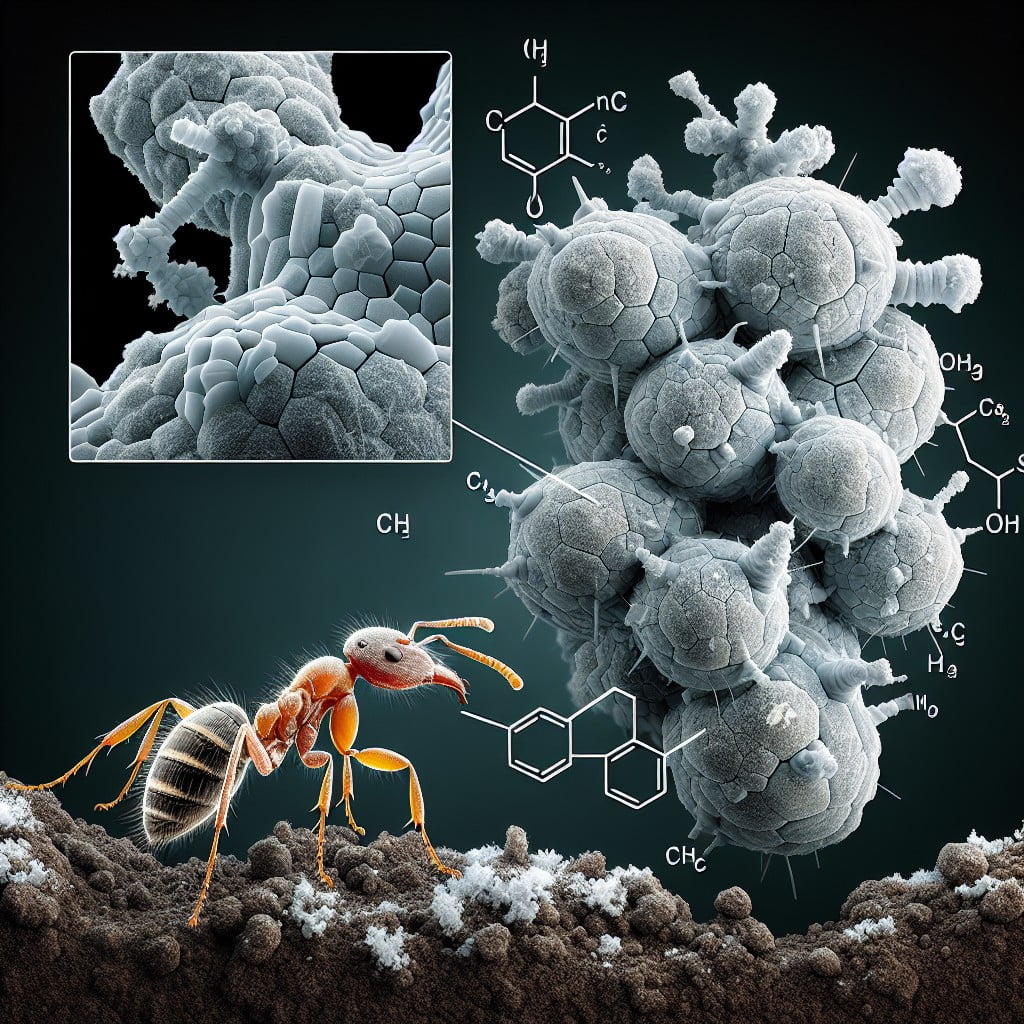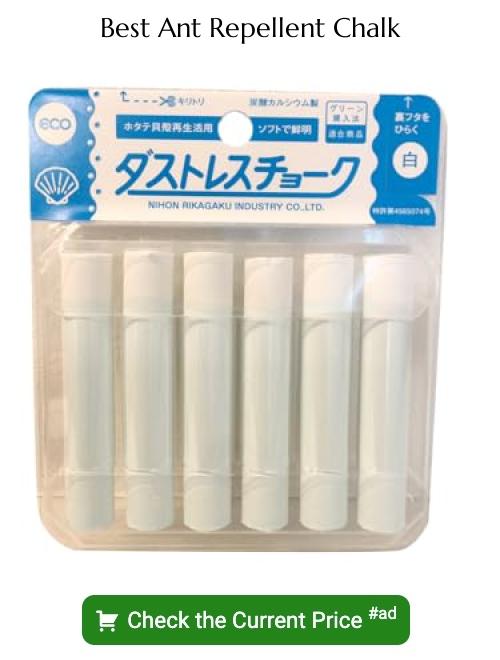Last updated on
Chalk, while not a definitive solution, can act as a temporary deterrent by disrupting ant trails, making it a potentially helpful tool in pest control strategies.
Key takeaways:
- Chalk acts as a temporary deterrent by disrupting ant trails.
- Ant chalk contains pyrethroid chemicals that disrupt ants’ nervous systems.
- Drawing a line with chalk creates a barrier that ants hesitate to cross.
- Ant chalk is easy to use but has potential health risks and environmental impact.
- Safer alternatives to ant chalk include white vinegar, pepper, borax, and diatomaceous earth.
What Is Ant Chalk?

Ant chalk, often referred to as “Chinese chalk,” is a type of insecticide that comes in a stick form resembling the chalk used on blackboards. This product is designed to target crawling insects, particularly ants and roaches.
Users draw lines with the chalk in areas where ants travel or congregate. When ants cross these lines, they pick up the insecticide with their bodies. As ants groom themselves and others, the poison is ingested, which ultimately leads to the colony’s eradication.
Despite its occasional effectiveness, it’s crucial to note that the presence of potent insecticides in the chalk can pose health risks, especially if used improperly or in environments with children and pets.
Chemical Composition

Ant repellent chalk, commonly known as “miraculous insecticide chalk” or “Chinese chalk,” often contains the active compounds deltamethrin or cypermethrin. Both substances belong to the pyrethroid family, which are synthetic chemicals modeled after the natural insecticidal qualities found in chrysanthemum flowers. Pyrethroids disrupt the nervous system of ants, leading to paralysis and eventual death.
It is crucial to note that despite their efficacy in pest control, such chemicals must be used with caution due to potential toxicity to humans and pets, especially when misused or applied without proper protective measures. The seemingly simple act of drawing a line with this chalk creates a barrier that ants are hesitant to cross, but the chemical itself is what ultimately keeps them at bay.
How It Works
Ant chalk, commonly containing the pesticide deltamethrin, creates a barrier that ants and other insects are reluctant to cross. When ants come into contact with this substance, the chemical works by disrupting their nervous system, which can lead to their eradication.
The effectiveness of the chalk depends on the ants’ level of exposure to the active ingredient. The method by which it is applied also plays a crucial role; drawing a line ensures the ants must cross it to reach their destination, increasing their exposure. It’s also worth noting that ant chalk should be reapplied regularly, as its efficacy can diminish over time and with exposure to the elements.
Pros and Cons of Using Ant Chalk
Understanding the advantages and disadvantages of ant chalk is crucial for making an informed decision about pest control. On the plus side, this method of warding off ants is incredibly easy to use. Simply drawing a line around entry points or the perimeter of a house creates an effective barrier. It’s also highly portable and does not require any specialized equipment or professional application, offering convenience for users.
Yet, for all its ease, ant chalk has significant drawbacks. Its toxicity not only poses risks to humans and pets if ingested, but also its residue can be harmful if it comes into contact with skin or is inhaled. The environmental impact should not be overlooked, as its chemical ingredients can harm non-target organisms and possibly contaminate soil and water sources.
Legality is another concern. Ant chalks containing certain pesticides might not be approved by regulatory bodies like the Environmental Protection Agency (EPA), limiting their use and availability. Additionally, overuse or reliance on chemical barriers can lead to ants developing resistance, diminishing the long-term effectiveness of ant chalk.
Weighing these pros and cons is vital to determining whether ant chalk is an appropriate choice for your pest control needs.
Safety Concerns
While ant chalk might seem like a convenient solution to an ant invasion, it’s vital to address the safety issues associated with its use. Many forms of ant chalk contain the insecticide deltamethrin, which can be harmful if ingested or inhaled by humans or pets.
Additionally, the ease of application poses a risk as it can be easily accessible to children and animals, who might mistake it for regular chalk. Improper use—such as applying it in areas with high human contact or not following the instructions—can increase the risk of exposure.
Protective gloves should be worn during application to prevent skin contact, and care must be taken to ensure that the chalk is applied strictly to areas out of reach of children and pets. Good ventilation is important if used indoors to prevent inhalation of any dust. Always read the label and follow the directions provided by the manufacturer to mitigate potential hazards.
Remember, in some regions, certain types of ant chalk may be illegal due to their toxicity and safety issues, so it’s advisable to check local regulations before purchasing or using this product.
Alternatives to Ant Chalk
For those opting for safer or more natural solutions to deter ants, consider the following methods:
White Vinegar: A mix of equal parts water and vinegar creates an acidic barrier that ants avoid. Spray this solution along entry points and the ants’ trail.
Cayenne or Black Pepper: Spicy substances like cayenne or black pepper act as deterrents. Sprinkle the powder where ants frequent to disrupt their scent trails.
Borax: Mixing borax with sweet bait can be an effective ant killer. The borax disrupts their digestive system once ingested. However, keep this away from pets and children, as it is toxic.
Diatomaceous Earth: This powder is made from fossilized algae and has sharp edges that can injure ants’ exoskeletons. Sprinkle in areas where ants are a problem, but use food-grade, not pool-grade, diatomaceous earth for safety.
Each of these alternatives can serve as a component of a comprehensive ant control strategy. Remember to target not just the ants you see but also their entry points to prevent future invasions.
Natural Ant Control Methods
Harnessing the power of natural substances can effectively discourage ant invasions:
White Vinegar: Spraying a solution of equal parts water and white vinegar along ant trails disrupts their scent trails and deters their progress.
Cayenne or Black Pepper: Spreading a line of these spices at entry points serves as a natural barrier ants are reluctant to cross.
Borax: A mixture of borax and sugar, placed where ants forage, can act as a slow-acting poison that workers bring back to the colony, reducing the population over time.
Diatomaceous Earth: This fine powder is made from fossilized algae and works mechanically. When ants crawl over it, the sharp edges cut through their exoskeletons, leading to dehydration.
Implementing these methods requires regular application and vigilance to maintain their efficacy against ant intrusions.
White Vinegar
Harnessing the power of white vinegar as an ant deterrent is a simple yet effective approach. Its strong scent makes it excellent for masking ants’ pheromone trails, which they use to navigate and communicate with the colony. When these trails are disrupted, ants lose their way and can’t find their source of food.
To create a natural ant repellent, dilute white vinegar with an equal amount of water in a spray bottle. Spritz the solution along baseboards, near entrances, and any other areas where ants have been spotted. For a more targeted treatment, apply the undiluted vinegar directly onto ant hills or wherever you notice a high level of activity.
Furthermore, routinely cleaning surfaces with a vinegar solution can prevent the future attraction of ants. Incorporate this into your cleaning regimen by wiping countertops, floors, and around pet bowls, making your home less appealing to these persistent invaders.
Remember, consistent application is key—reapply the solution as needed to maintain its effectiveness and keep your home ant-free.
Cayenne or Black Pepper
Pepper – both cayenne and black – acts as a powerful deterrent for ants due to its strong, spicy scent that disrupts their scent trails.
Here’s how to use pepper to keep ants at bay:
1. Sprinkle a line of pepper at entry points where ants are known to invade. The potent smell masks their trail pheromones, making it difficult for other ants to follow.
2. For a wider barrier, scatter pepper around the perimeter of your home or specific areas like gardens.
3. Create a pepper solution by mixing it with water and spraying it onto ant-prone surfaces. This will help in maintaining the effect even when the sprinkled pepper gets scattered or blown away.
Remember, regular replenishment of the pepper is necessary, especially after cleaning or rain, to ensure continuous efficacy in ant prevention.
Borax
Borax, also known as sodium borate, is a common household chemical that serves as an effective ant deterrent. Here’s how you can use it to keep ants at bay:
- Create a borax bait: Mix borax with sweet substances like sugar or honey to attract ants. The ants are drawn to the bait and carry the mixture back to their colony, affecting the ants at the source.
- Formulate a solution: Dissolve borax in water to make a spray or wipe. Applying this solution along ant trails and entry points disrupts their scent trails and deters their return.
- Sprinkle as a barrier: A thin line of dry borax can act as a barrier that ants are reluctant to cross, preventing them from accessing certain areas of your home.
- Combine with other deterrents: Enhance the effectiveness by combining borax with other natural repellents, such as essential oils or citrus peels.
Remember to exercise caution if you have pets or children; borax should be kept out of their reach as it can be harmful if ingested in significant quantities.
Diatomaceous Earth
Composed of the fossilized remains of tiny aquatic organisms called diatoms, diatomaceous earth (DE) works by absorbing oils and fats from the exoskeleton of insects, leading to dehydration and death. This fine powder is a highly effective method for controlling ants without the use of harsh chemicals.
When using DE for ant control:
- Choose food-grade diatomaceous earth for a pet-friendly option.
- Sprinkle a thin layer of DE along ant trails and entry points.
- Reapply after any heavy dew or rain, as moisture reduces its effectiveness.
- Keep in mind that DE can take a few days to have an impact on the ant population.
- Avoid inhaling DE, as the fine particles can be irritating to the lungs.
By adhering to these tips, you can use diatomaceous earth as a safe and natural deterrent against ants invading your space.
Is Chinese Ant Chalk Effective?
Chinese ant chalk, also known as “Miraculous Chalk” or “Chinese Chalk,” has gained a reputation for its effectiveness in controlling ant populations. The chalk contains insecticides, such as deltamethrin, which are potent in disrupting the nervous system of ants upon contact.
When ants cross lines drawn with this chalk, they pick up the insecticide and eventually die after exposure. Moreover, ants are social insects, so they can carry the poison back to their colony, potentially eliminating a larger number of individuals.
However, efficacy can vary depending on the species of ants and the proper application of the chalk. Consistent use and strategic placement in areas of high ant traffic are crucial for success.
Importantly, while the chalk has been renowned for its effectiveness, regulatory agencies have expressed concerns about user safety and the legality of these products, leading to bans in several countries.
Where Can I Buy Ant Chalk?
If you’re considering purchasing ant chalk, it is important to opt for products that are registered and approved by local regulatory agencies such as the Environmental Protection Agency (EPA) in the United States. These can usually be found in hardware stores, home improvement centers, or online marketplaces like Amazon.
When shopping online, read product descriptions and reviews to ensure the ant chalk is effective and safe for your intended use. It’s crucial to verify the legality of ant chalk in your area since products like Chinese ant chalk are often considered illegal due to their toxic and unregulated ingredients.
If you’re unsure about the regulations, consult your local pest control professionals or the appropriate government agency for guidance on approved ant deterrents.
Is Ant Chalk Safe to Use Around Pets?
Pet owners should exercise caution when using ant chalk, due to the potential for harmful effects. The toxic substances found in various chalk products, particularly those not approved by environmental agencies, may pose health risks if ingested by animals.
Symptoms such as gastrointestinal upset, drooling, lack of appetite, and more severe neurological issues could arise if pets come into contact with or consume the chalk.
To mitigate risks, keep chalk out of reach and monitor pets during use. Always clean up any chalk residue promptly and wash your hands thoroughly after application.
For households with pets, it’s advisable to consider pet-friendly alternatives for ant control. If accidental exposure occurs, seek immediate veterinary assistance and provide product information for proper treatment.
FAQ
How do you use chalk to get rid of ants?
To repel ants effectively, draw a line using chalk near the area from which you want to keep them away, disrupting their pheromone trails and forcing them to find an alternative pathway.
Does white chalk get rid of ants?
White chalk does not eliminate ants; it merely disrupts their scent trail temporarily, and they quickly adapt to find alternate routes in their quest for nourishment.
Why do ants hate sidewalk chalk?
Ants detest sidewalk chalk due to its powdery texture which interrupts their chemical trails, leaving them disoriented and without a clear route to navigate.
What is the science behind chalk deterring ants?
Chalk deters ants because its particles disrupt and mask the scent trail that ants use to navigate, causing confusion and preventing them from finding food sources.
Are certain types of chalk more effective against ants compared to others?
While there’s a belief that chalk can deter ants, there’s no scientific evidence to support this claim, and effectiveness does not change based on chalk type.
Can the use of chalk be a long-term solution for an ant infestation?
No, chalk is not a long-term solution for an ant infestation as it merely deters ants temporarily, without addressing the root cause of the infestation.
Recap:





